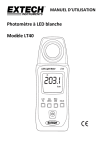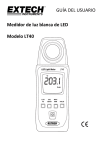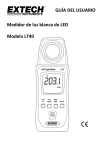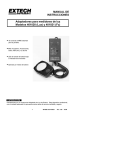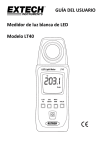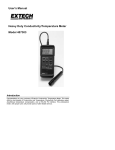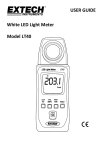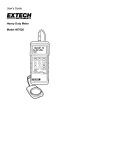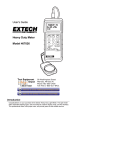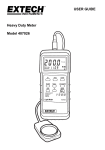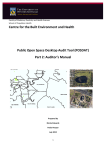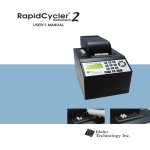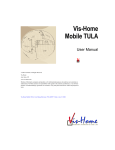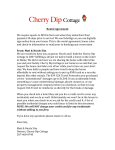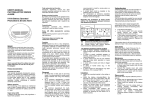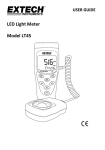Download Instruction Manual
Transcript
User's Manual Model 407026 Heavy Duty Light Meter Introduction Congratulations on your purchase of Extech’s Heavy Duty Light Meter. This light meter offers selectable lighting types, data record/recall, relative display mode, and PC interface. This professional meter, with proper care, will provide years of safe reliable service. Specifications General Specifications Circuit Display Custom one-chip LSI microprocessor circuit Dual function 0.5" (13 mm) 3-1/2 digit (1999 count) LCD display with contrast adjustment Measurement & Ranges LUX: 0 to 50,000 LUX (3 range); Fc: 0 to 5000 Fc (3 range); Relative mode: 0 to 1999% Data hold Freezes Display Lighting Types Sodium, Daylight/Tungsten, Fluorescent or Mercury Sensor Structure Cosine/color corrected photo-diode meets C.I.E. Memory Store/Recall Records/Recalls Max/Min/Avg readings Sample rate 0.4 sec. approx. Zero Adjust Push button Auto Power Off After approx. 10 min Data Output RS 232 PC serial interface (optional software) Operating conditions 32 °F to 122 °F (0 °C to 50 °C); <80% RH Power Supply DC 9V battery (Heavy duty type). Power consumption Approx. 5 mA DC. (approx. 200 hr battery life) Weight 0.71 lbs. (320 g) Dimensions Instrument: 7.1 x 2.8 x1.3" (180 x 72 x 32 mm) Sensor: 3.3 x 2.2 x 0.7" (85 x 55 x 17.5 mm) Range Specifications Measurement Range LUX 2,000 LUX 20,000 LUX 50,000 LUX Display 0-1,999 LUX 1,800-19,990 LUX 18,000-50,000 LUX Resolution 1 LUX 10 LUX 100 LUX Foot Candle 0-186.0 Fc 167-1,860 Fc 1,670-5,000 Fc 0.1 Fc 1 Fc 10 Fc 1% Relative mode 200 Fc 2,000 Fc 5,000 Fc 0-1999% Accuracy +(4% + 2 digits) (% full scale) Note: The accuracy specification above applies to calibration performed using a precision standard incandescent tungsten light source of 2856OK with meter on the tungsten setting. Meter Description 1 LCD Display 2 3 4 5 Keypad Light sensor Battery compartment (rear) Sensor input socket 6 7 RS232 output socket Protective Holster 2 407026 Ver. 2.1 1/01 Operation 1 Press the "Power Off/On" key to power the meter. Check the battery if display does not indicate characters. 2 Zero Calibration for Sensor a) Place the "Sensor Cover" over the "Light Sensor". b) Select the "2,000 LUX" range via the "Range Switch". c) Press the "Zero" key. The display will null (display zero). d) Remove the Sensor Cover from the Light Sensor. 3 Select the desired unit of measure by pressing the "LUX/Fc" key. The display will indicate "LUX" or "Fc" as selected. 4 Select the type of lighting to be measured by pressing the "Light Source Select" key. The display will indicate the lighting type icon from the list below: L = Tungsten/Daylight; F = Fluorescent; S = Sodium; C = Mercury (For Halogen and Metal Halide light use the Tungsten setting) 5 When making measurements always start at the highest range and work down (use the "Range Switch" to select ranges). If the display indicates "----", the input exceeds the maximum for the range; Select a higher range. If the display indicates "_ _ _ _", the input is too low; Select a lower range. 6 Hold the "Light Sensor" so that the sensor faces the light source to be measured. The display will indicate the light intensity value. In the 20,000 LUX and 5,000 Fc ranges, the last digit will appear on the lower line of the LCD display. In the 50,000 LUX range, the last two digits will appear on the lower line of the LCD display. Data Hold: During the measurement, pressing "Data Hold" will freeze the displayed value and the LCD will display the "D.H" indicator. Press "Hold" again to release the data hold function. Relative % Mode : During measurements, pressing the "%" key causes the display to read 100%. This means that the reading on the LCD at the time of the key-press = 100% and all subsequent readings will be relative to that reading. For example if 100 Fc was on the display at the time of the key-press and the next reading was 50 Fc, the display would read 50% since 50 Fc is 50% of 100 Fc. New % values are calculated as: Measured Light Value --------------------------------------------------------------------------- X 100 Reference Light Value (when % is pressed) Press the "%" key again to release the relative % light function and return to normal operation. Data Record (MAX/MIN/AVG Readings) When selected, the DATA RECORD function records and stores the maximum, minimum and average readings. To start the DATA RECORD function: a) Press "RECORD" once. The "REC" indicator will appear on the display. b) Press "RECALL" once to retrieve the "Max" reading. The "Max" indicator along with the maximum values will appear on the LCD display. c) Press "RECALL" once, the "Min" indicator along with the minimum values will appear on the LCD display. d) Press "RECALL" once, the "AVG" indicator along with the average values will appear on the LCD display. e) To disable the "Data Record " function, press "Record" again. The display indicators "REC", "Max", "Min", "AVG" will disappear. 3 407026 Ver. 2.1 1/01 Measurement Considerations 1 2 3 4 The meter is designed with an "Auto shut off" feature to conserve battery life. The meter will automatically turn off if a function button is not pressed in any 10 minutes period. To disable "Auto shut off", press the "RECORD" button to engage the record function. It may be necessary to adjust the display contrast due to a change in viewing angle or voltage drift. Use the "LCD Contrast adjustment" located on the right side of the meter to set the preferred contrast. The Zero recalibration procedure described in a previous section should be followed whenever the meter is powered up. When recalibrating use a tungsten lamp (2856 oK) and be sure to select "Tungsten" as the light source. RS232 PC Interface The meter has a RS232 serial data port. This interface was designed to operate with the Extech Data Acquisition Software (p/n 407000) and enables the user to capture, store and display readings on a PC. For more information, contact Extech or refer to the 407000 user's manual for details on the PC interface. Battery Replacement The low battery indication appears as a "LBT" on the left corner of the display. When the "LBT" appears, replace the battery as soon as possible. Reliable readings can be obtained for several hours after the first appearance of the low battery indication. To replace the battery: 1 Remover the meter's rubber protective holster. 2 Pry the Battery Cover off using a small coin or screwdriver and remove the battery. 3 Replace the 9V battery (heavy duty type) and reinstall the cover. 4 Make sure the battery cover is secured after changing the battery. Calibration and Repair Services Extech offers complete repair and calibration services for all of the products we sell. For periodic calibration, NIST certification or repair of any Extech product, call customer service for details on services available. Extech recommends that calibration be performed on an annual basis to insure calibration integrity. Warranty EXTECH INSTRUMENTS CORPORATION warrants this instrument to be free of defects in parts and workmanship for three years from date of shipment (a six month limited warranty applies on sensors and cables). If it should become necessary to return the instrument for service during or beyond the warranty period, contact the Customer Service Department at (781) 890-7440 ext. 210 for authorization. A Return Authorization (RA) number must be issued before any product is returned to Extech. The sender is responsible for shipping charges, freight, insurance and proper packaging to prevent damage in transit. This warranty does not apply to defects resulting from action of the user such as misuse, improper wiring, operation outside of specification, improper maintenance or repair, or unauthorized modification. Extech specifically disclaims any implied warranties or merchantability or fitness for a specific purpose and will not be liable for any direct, indirect, incidental or consequential damages. Extech's total liability is limited to repair or replacement of the product. The warranty set forth above is inclusive and no other warranty, whether written or oral, is expressed or implied. Copyright © 2001 Extech Instruments Corporation. All rights reserved including the right of reproduction in whole or in part in any form. 4 407026 Ver. 2.1 1/01 Typical Light Levels Lux Foot Candles Factories Emergency Stairs, Warehouse Exit/Entrance Passages Packing Work Visual Work: Production Line Typesetting: Inspection Work Electronic Assembly, Drafting Office 75-100 7-10 Indoor Emergency Stairs 100-200 10-20 Corridor Stairs 200-750 20-75 Conference, Reception Room 750-1,500 75-150 Clerical Work 1,500-2,000 150-2000 Typing, Drafting Store 75-150 7-15 Indoors 150-200 15-20 Corridor/Stairs 200-300 20-30 Reception 300-500 30-50 Display Stand 500-750 50-75 Elevator 750-1,500 75-150 Show Window, Packing Table 1,500-3,000 150-300 Storefront, Show Window 20-75 2-7 75-150 7-15 150-300 15-30 300-750 30-75 750-1,500 75-150 1,500-3,000 150-300 Lux Foot Candles 100-150 150-200 200-300 300-500 500-1,500 1,000-2,000 10-15 15-20 20-30 30-50 50-150 100-200 75-150 150-300 300-750 750-1,500 7-15 15-30 30-75 75-150 30-75 3-7 75-100 7-10 100-150 10-15 150-200 15-20 200-750 20-75 750-1,500 75-150 5,000-10,000 500-1000 Home Washing Recreational Activities Drawing Room, Table Makeup Reading, Study Sewing Restaurant Corridor Stairs Entrance, Wash Room Cooking\Dinning Room Show Window Hospital Emergency Stairs Stairs Sick Room, Warehouse Waiting Room Medical Exam Room Operating Room Eye Inspection Common Conversion Factors Illuminance (Visible Flux Density) 1 lm/m2 = 1 lux (lx) 10-4 lm/cm 2 10-4 phot (ph) 9.290 x 10-2 lm/ft2 Luminance (Visible Flux Density per Solid Angle) 1 lm/m2/sr = 1 lm/sr = 1 lumen (lm) = Luminous Intensity (Visible Flux per Solid Angle) Luminous Flux ( Visible Flux) 9.290 x 10-2 foot-candles 1 candela/m2 1 candella 1.464 x 10-3 watts @ 555 nm ( Tech Support Hotlines 781-890-7440 ext. 200 [email protected] www.extech.com 5 407026 Ver. 2.1 1/01





